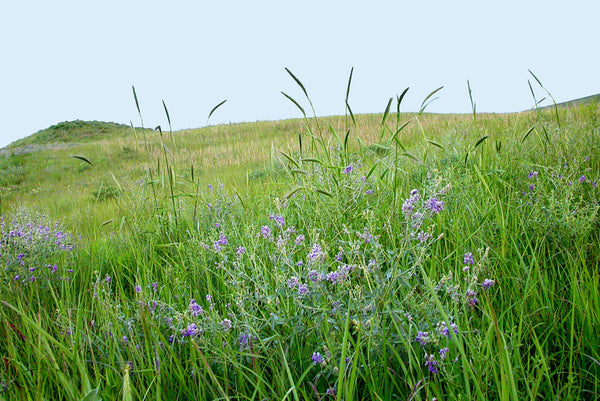
A Closer Look: Tallgrass Prairies & The Katahdin Lamb
The Katahdin/White Dorper is a crossbreed bred by Joseph Hubbard at Shannon Creek Ranch in the Flint Hills of Kansas. The Dorper has a lot more muscle than the Katahdin. Combined you get a meaty lamb with the mild taste of the Katahdin.
Heritage Foods USA considers the Flint Hills to be the best terroir for grass-fed animal farming in the U.S. The Flint Hills are band of hills that stretches from eastern Kansas into north-central Oklahoma, extending from Marshall and Washington Counties in Kansas in the north, to Cowley County in Kansas and Kay and Osage Counties in Oklahoma in the south.
Anywhere tallgrass grows makes for a great and sustainable terroir for grass-fed sheep, but what makes the Flint Hills our number one choice is that it boasts the most dense cover-age of intact tall grass prairie in North America and has blossomed into a mosaic of independent family farms— many of which are at the heart of the heritage breed movement.
Tallgrass is the food the prairie produces naturally in the absence of intensive row-crop agriculture. Unlike corn, tallgrass is not dependent on petrochemical fertilizer or herbicide, and its roots run deep below the thin layer of topsoil. It is potent, incredibly resilient, the all-you-can-eat salad bar for healthy sheep. And they love it, gladly eating pounds of the stuff every day.
Konza Prairie, Manhattan, Kansas
The result of this robust food supply is a meat with a nice even ratio of intra- and extra-muscular fat, a clean taste, a natural delight. It is the taste of the Americas.
Varietals like Bluestem, Little Bluestem, Indiangrass, Switchgrass, Prairie Dropseed, and Sideoats Grama have stalks whose profound roots are able to pull moisture and nutrients from deep within the ground, making them the best candidates to withstand the drought and deluge likely to accompany climate change. They are resistant to all types of extreme weather, and they bounce back quickly, even from fires. And they do not rely on the dwindling power of the thin layer of topsoil to grow.
Taste Notes for the Katahdin (what are yours?)
Savory
Mushroomy
Honey
Clover
Spicy and peppery
Creamy fat
Barky and woody
The Katahdin is inextricably linked to Michael Piel of Abbott, Maine who had the brilliant idea of separating out the wool producing side of the lamb business from the meat side. Wool production took time and energy from both the animals and the farmers while only providing about 10 percent of the farmer’s income. In addition wool creates a more pungent and muttony taste in the meat.
Piel imported three hair sheep from the Virgin Islands and bred them with various breeds like Tunis and Suffolk in an effort to produce a sheep that excels in taste. The result of the crossbreeding efforts finally produced a flock so perfect that it became the foundation for a herd and eventually the Katahdin breed that is raised around the country. Piel named it after a mountain in Maine even though the breed excels in hotter climates. The Katahdin is known to live a long time while remaining productive. There are now a couple of hundred U.S. breeders of the Katahdin including our very own Chris Wilson of Clover Creek who has worked with us for almost a decade.
The Katahdin serves land conservation projects very well and are perfect for grass-fed systems like that found in Northeastern Tennessee where Chris has won awards for land conservation.
